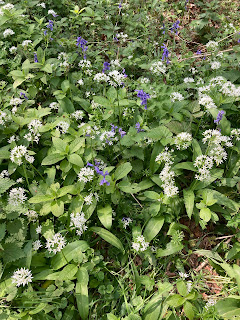Wild Garlic

This blog is about a recent trip to Lower Wood Ashwellthorpe, a Norfolk Wildlife Trust reserve, to look at ancient woodland indicators. One of these is Wild Garlic or Ramsons ( Allium ursinum ). Wild Garlic interspersed with English Bluebells (another ancient woodland indicator species). These beautiful white flowers coat the woodland floor during spring, and have a strong garlic scent, making them difficult to miss. Each flower has 6 bright white petals and cluster in groups of around 25 on the end of the stems, appearing like pompoms. Flowering early in the spring allows the plants to make the most of the sunlight reaching the forest floor before the canopy emerges and it is much shadier. Wild Garlic is in the same family (Alliaceae) as onions, chives, leeks, daffodils, and other garlics. It reproduces by bulb division and occasionally seeds. It provides an important nectar source for early pollinators and the bulbs are eaten by Wild Boar ( Sus scrofa ), though these are not found at...

.jpg)






